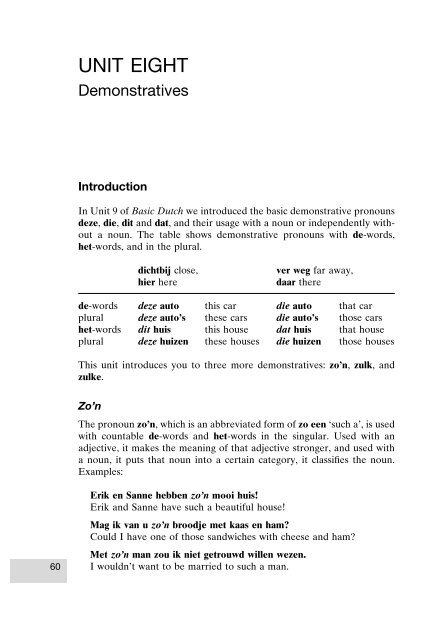er - Home
er - Home
er - Home
Create successful ePaper yourself
Turn your PDF publications into a flip-book with our unique Google optimized e-Paper software.
60<br />
UNIT EIGHT<br />
Demonstratives<br />
Introduction<br />
In Unit 9 of Basic Dutch we introduced the basic demonstrative pronouns<br />
deze, die, dit and dat, and their usage with a noun or independently without<br />
a noun. The table shows demonstrative pronouns with de-words,<br />
het-words, and in the plural.<br />
dichtbij close, v<strong>er</strong> weg far away,<br />
hi<strong>er</strong> h<strong>er</strong>e daar th<strong>er</strong>e<br />
de-words deze auto this car die auto that car<br />
plural deze auto’s these cars die auto’s those cars<br />
het-words dit huis this house dat huis that house<br />
plural deze huizen these houses die huizen those houses<br />
This unit introduces you to three more demonstratives: zo’n, zulk, and<br />
zulke.<br />
Zo’n<br />
The pronoun zo’n, which is an abbreviated form of zo een ‘such a’, is used<br />
with countable de-words and het-words in the singular. Used with an<br />
adjective, it makes the meaning of that adjective strong<strong>er</strong>, and used with<br />
a noun, it puts that noun into a c<strong>er</strong>tain category, it classifies the noun.<br />
Examples:<br />
Erik en Sanne hebben zo’n mooi huis!<br />
Erik and Sanne have such a beautiful house!<br />
Mag ik van u zo’n broodje met kaas en ham?<br />
Could I have one of those sandwiches with cheese and ham?<br />
Met zo’n man zou ik niet getrouwd willen wezen.<br />
I wouldn’t want to be married to such a man.


